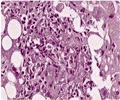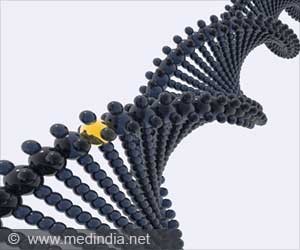- There is no easy way to determine which microbe, either virus or bacteria, is causing pneumonia
- This uncertainty makes it harder for doctors to choose an effective treatment plan that works
- Now, a nanoparticle sensor will help doctors to clarify this confusion and avoid the unnecessary use of antibiotics
Even with the most extensive and advanced testing, the specific pathogen causing someone’s disease can’t be identified in about half of patients. This uncertainty makes it harder for the treatment plan and leads to the overuse of antibiotics.
Researchers showed that their new nanoparticle sensors could accurately distinguish bacterial and viral pneumonia within two hours, using a simple urine test in mice.
Signatures Of Infection
One reason why it has been difficult to distinguish between viral and bacterial pneumonia is that there are so many microbes that can cause pneumonia, including the bacteria Streptococcus pneumoniae and Haemophilus influenzae, and viruses such as influenza and Respiratory Syncytial Virus (RSV).In designing their sensor, the research team decided to focus on measuring the host’s response to infection, rather than trying to detect the pathogen itself.
Viral and bacterial infections provoke distinctive types of immune responses, which include the activation of enzymes called proteases, which break down proteins. They found that the pattern of activity of those enzymes can serve as a signature of bacterial or viral infection (1✔ ✔Trusted Source
Protease activity sensors noninvasively classify bacterial infections and antibiotic responses
Go to source).
The human genome encodes more than 500 types of those enzymes, and many of these are used by cells that respond to infection, including T cells, neutrophils, and natural killer (NK) cells.
Keeping this in mind, researchers collected 33 publicly available datasets of genes that are expressed during respiratory infections. By analyzing those data, they were able to identify 39 proteases that appear to respond differently to different types of infection.
Later, they used those data to create 20 different sensors that can interact with those proteases. The sensors consist of nanoparticles coated with peptides that can be cleaved by particular proteases.
Each peptide is labeled with a reporter molecule that is freed when the peptides are cleaved by proteases that are upregulated in infection. Those reporters are eventually excreted in the urine. The urine can then be analyzed with mass spectrometry to determine which proteases are most active in the lungs.
How To Identify The Cause Of Pneumonia?
Researchers then tested their sensors in five different mouse models of pneumonia, caused by infections of Streptococcus pneumoniae, Klebsiella pneumoniae, Haemophilus influenzae, influenza virus, and pneumonia virus of mice.After reading out the results from the urine tests, they used machine learning to analyze the data. Using this approach, they were able to train algorithms that could differentiate between pneumonia versus healthy controls, and also distinguish whether an infection was viral or bacterial, based on those 20 sensors(2✔ ✔Trusted Source
Host protease activity classifies pneumonia etiology
Go to source).
They also found that their sensors could distinguish between the five pathogens they tested, but with lower accuracy than the test to distinguish between viruses and bacteria.
One possibility the researchers may pursue is developing algorithms that can not only distinguish bacterial from viral infections but also identify the class of microbes causing bacterial infection, which could help doctors choose the best antibiotic to combat that type of bacteria.
The urine-based readout is also amenable to future detection with a paper strip, similar to a pregnancy test, which would allow for point-of-care diagnosis.
To this end, the researchers identified a subset of five sensors that could put at-home testing closer within reach. However, more work is needed to determine if the reduced panel would work similarly well in humans, who have more genetic and clinical variability than mice.
Varying Response To Infection
In this study, researchers also identified some patterns of the host response to different types of infection. In mice with bacterial infections, proteases secreted by neutrophils were more prominently seen, which was expected because neutrophils tend to respond more to bacterial infections than viral infections.Viral infections, on the other hand, provoked protease activity from T cells and NK cells, which usually respond more to viral infections. One of the sensors that generated the strongest signal was linked to a protease called granzyme B, which triggers programmed cell death (3✔ ✔Trusted Source
Nanoparticle sensor can distinguish between viral and bacterial pneumonia
Go to source).
Researchers found that this sensor was highly activated in the lungs of mice with viral infections and that both NK and T cells were involved in the response.
To deliver the sensors to mice, they injected them directly into the trachea, but they are now developing versions for human use that could be administered using either a nebulizer or an inhaler similar to an asthma inhaler.
They are also working on a way to detect the results using a breathalyzer instead of a urine test, which could give results even more quickly.
References:
- Protease activity sensors noninvasively classify bacterial infections and antibiotic responses - (https://www.thelancet.com/article/S2352-3964(18)30535-8/fulltext)
- Host protease activity classifies pneumonia etiology - (https://www.pnas.org/doi/10.1073/pnas.2121778119)
- Nanoparticle sensor can distinguish between viral and bacterial pneumonia - (https://news.mit.edu/2022/sensor-viral-bacterial-pneumonia-0613?utm_source=The+Medical+Futurist+Newsletter&utm_campaign=ae0cb6ee41-EMAIL_CAMPAIGN_2022_06_26_Resend&utm_medium=email&utm_term=0_efd6a3cd08-ae0cb6ee41-420899027&mc_cid=ae0cb6ee41&mc_eid=9b0313055c)
Source-Medindia
















